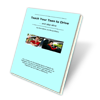 |
|
Speeders now getting "the book" thrown at them It is another way to get traffic violation points taken off your license. by TIMOTHY GIBBONS From the "speed kills" billboard above Interstate 95 to the "enhanced penalty zone" warning sides along side it, it shouldn't be difficult to keep that lead foot off the gas pedal. Tell that to the 312,191 people who got tickets of various sorts in Duval County last year. For some of those drivers, dealing with that ticket meant going to driver school – and for years, "going to school" meant exactly that: sitting in a classroom for four hours while an instructor told you how to be a better driver. Technology marches on, however, and over the past few years the state has certified courses offered on videotape, DVD and online. (A list of schools licensed by the state is here: www.hsmv.state.fl.us/ddl/bdis.html.) The newest option: "Funny in Florida," the first book-based traffic school system to be approved by Florida. The course combines the "comedic traffic safety courses" that Traffic Safety Consultants offers in other mediums with the book that Director of Operations Lawrence Gentilucci said has been popular in California, the company's home base. "When we got to Florida, we found only classroom instruction, Internet and video, but no book. That's one of our biggest and most attractive ways to take traffic school in California," Gentilucci said. "We found it to be a better learning tool for some students." The Basic Driver Improvement Course/Traffic Collision Avoidance Course is a way for errant drivers to get points off their record – a necessity if you've wracked up 12 points in a year, which earns a 30-day suspension. Some drivers also opt to take the class because some insurance companies provide discounts for attendance. One difference between California and Florida: In the Sunshine State, the Department of Highway Safety and Motor Vehicles is strict on the four-hour minimum teaching time. This required Traffic Safety Consultants to come up with a way to make sure students spent at least four hours reading the book, as well as passing a 50-question final exam either online or on paper, before getting a certificate of completion. The solution: Having students check in as they progress through the five-chapter, 160-page book, either logging in on the school's website or calling in to a call center. To make sure that the student is actually studying the book during the 45 minutes or so each chapter is supposed to take, the system will ask the reader questions that relate to non sequitur "validation inserts" – short sentences that have nothing to do with driving that have been inserted in the text: For example, what is the state fruit? Answer: The strawberry. Even with those strictures, Gentilucci said, the book has a good chance of picking up a hefty slice of the 60 percent of students who go through traffic school at home. "Students are so familiar with the process of learning from a book," he said. "It's too convenient a product. It has real value for the user." timothy.gibbons@jacksonville.com |



 Teach Your Teen to Drive…and stay alive is a fun and
informative book that helps parents and teens to fulfill the practice driving
requirements.
Teach Your Teen to Drive…and stay alive is a fun and
informative book that helps parents and teens to fulfill the practice driving
requirements. 

